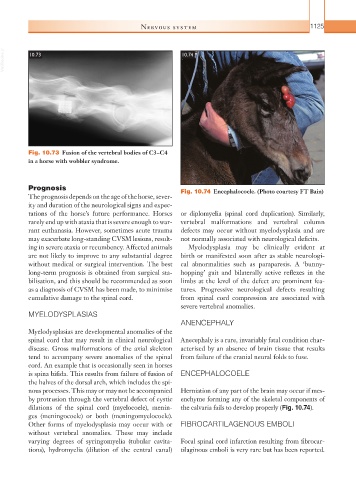Page 1150 - Equine Clinical Medicine, Surgery and Reproduction, 2nd Edition
P. 1150
Nervous system 1125
VetBooks.ir 10.73 10.74
Fig. 10.73 Fusion of the vertebral bodies of C3–C4
in a horse with wobbler syndrome.
Prognosis Fig. 10.74 Encephalocoele. (Photo courtesy FT Bain)
The prognosis depends on the age of the horse, sever-
ity and duration of the neurological signs and expec-
tations of the horse’s future performance. Horses or diplomyelia (spinal cord duplication). Similarly,
rarely end up with ataxia that is severe enough to war- vertebral malformations and vertebral column
rant euthanasia. However, sometimes acute trauma defects may occur without myelodysplasia and are
may exacerbate long-standing CVSM lesions, result- not normally associated with neurological deficits.
ing in severe ataxia or recumbency. Affected animals Myelodysplasia may be clinically evident at
are not likely to improve to any substantial degree birth or manifested soon after as stable neurologi-
without medical or surgical intervention. The best cal abnormalities such as paraparesis. A ‘bunny-
long-term prognosis is obtained from surgical sta- hopping’ gait and bilaterally active reflexes in the
bilisation, and this should be recommended as soon limbs at the level of the defect are prominent fea-
as a diagnosis of CVSM has been made, to minimise tures. Progressive neurological defects resulting
cumulative damage to the spinal cord. from spinal cord compression are associated with
severe vertebral anomalies.
MYELODYSPLASIAS
ANENCEPHALY
Myelodysplasias are developmental anomalies of the
spinal cord that may result in clinical neurological Anecephaly is a rare, invariably fatal condition char-
disease. Gross malformations of the axial skeleton acterised by an absence of brain tissue that results
tend to accompany severe anomalies of the spinal from failure of the cranial neural folds to fuse.
cord. An example that is occasionally seen in horses
is spina bifida. This results from failure of fusion of ENCEPHALOCOELE
the halves of the dorsal arch, which includes the spi-
nous processes. This may or may not be accompanied Herniation of any part of the brain may occur if mes-
by protrusion through the vertebral defect of cystic enchyme forming any of the skeletal components of
dilations of the spinal cord (myelocoele), menin- the calvaria fails to develop properly (Fig. 10.74).
ges (meningocoele) or both (meningomyelocoele).
Other forms of myelodysplasia may occur with or FIBROCARTILAGENOUS EMBOLI
without vertebral anomalies. These may include
varying degrees of syringomyelia (tubular cavita- Focal spinal cord infarction resulting from fibrocar-
tions), hydromyelia (dilation of the central canal) tilaginous emboli is very rare but has been reported.

